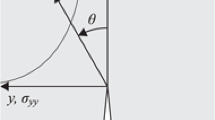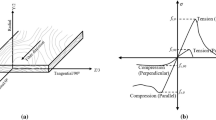Abstract
Predicting the load-carrying capacity of timber beams with holes cannot be performed by usual analysis methods if the failure of the beam is governed by the crack initiation and propagation around the hole at low load levels. Predicting the cracking load is an important design issue because it corresponds to the load-carrying capacity of the timber beam before the crack propagation. One of the models that can be used for the fracture formulation is that of a beam on elastic foundation. In this model a part of the beam is assumed to follow the conditions of beam with elastic foundation which has spring stiffness equal to the fracture properties of the material in the crack surface. Based on beam on elastic foundation model, the cracking load prediction is the target of the paper. Some closed form solutions for the beam with hole are presented. The formulation has been derived for two cases of pure shear and pure bending moment. Finally a semi-empirical formulation for combination of shear and bending moment in the section is presented. The model predictions are compared with the results of an experimental program showing good correlation. The analytical model can therefore be proposed for future revisions of codes of practice such as the Eurocode 5.
Zusammenfassung
Die Tragfähigkeit von Holzbalken mit Durchbrüchen kann nicht mit herkömmlichen Methoden bestimmt werden, wenn der Bruch darauf zurückzuführen ist, dass am Durchbruch ein Riss bei einer geringen Belastung entsteht und sich fortpflanzt. Die Bestimmung der Risslast, d.h. der Last bei der Entstehung des Risses, ist ein wichtiger Bemessungsaspekt, da sie die Tragfähigkeit des Holzbalkens vor der Rissfortpflanzung angibt. Eines der Modelle, das für die Bruchformulierung verwendet werden kann, ist das des elastisch gebetteten Balkens. In diesem Modell wird davon ausgegangen, dass ein Teil des Balkens einem elastisch gebetteten Balken entspricht, wobei die Federsteifigkeit den Brucheigenschaften des Materials in der Rissfläche entspricht. Ziel dieser Arbeit ist die Bestimmung der Risslast unter Verwendung des Modells des elastisch gebetteten Balkens. Es werden einige geschlossene Lösungen für einen Balken mit Durchbruch vorgestellt. Die Formulierung wird für die zwei Fälle reiner Schub- und reiner Biegebeanspruchung hergeleitet. Weiterhin wird eine halbempirische Formulierung für eine Kombination von Schub- und Biegebeanspruchung dargestellt. Die Modellvorhersagen werden mit den Ergebnissen eines Versuchsprogramms verglichen und zeigen eine gute Korrelation. Aus diesem Grund kann das analytische Modell zur Verwendung für zukünftige Revisionen anerkannter technischer Regeln wie zum Beispiel dem Eurocode 5 vorgeschlagen werden.











Similar content being viewed by others
References
Aicher S, Hofflin L (2000) A contribution to the analysis of glulam beams with round holes. J Otto-Graf Inst Stuttgart, Germany 11:167–188
Aicher S, Hofflin L (2008) Fracture behavior and design of Glulam beams with round holes. Paper presented at the Engineered Wood Product Association (EWPA), Paper 019. Online http://www.ewpa.com
Ardalany M, Deam B, Fragiacomo M (2010a) Numerical investigation of the load carrying capacity of Laminated Veneer Lumber (LVL) joists with holes. Paper presented at the World Conference WCTE2010, Riva del Garda, Italy
Ardalany M, Deam B, Fragiacomo M, Crews K (2010b) Tension perpendicular to grain strength of wood, Laminated Veneer Lumber (LVL) and cross banded LVL (LVL-C). Paper presented at the 21st Australasian conference on the mechanics of structures and materials, Melbourne, Victoria, Australia
Ardalany M, Deam B, Fragiacomo M (2012) Experimental results of fracture energy and fracture toughness evaluation of Radiata pine Laminated Veneer Lumber (LVL) in mode I (opening). J Mater Struct RILEM 1–17. doi:10.1617/s11527-012-9826-1
Chan PW, Redwood RG (1974) Stresses in beams with circular eccentric web hole. J Struct Div Am Soc Civil Eng (ASCE) 100(1):231–248
Danielsson H (2007) The strength of glulam beams with holes: a survey of tests and calculation methods. LUND University, Sweden
Danielsson H (2009) The strength of glulam beams with holes: a probabilistic fracture mechanics method and experimental tests. LUND University, Lund
DIN 1052-08 (2008) Design of timber structures—general rules and rules for buildings (In German). Construction Standards Committee (NABau) at DIN, Berlin, Germany. doi:10.1520/D2915-03
Guan ZW, Pope DJ (2006) Modelling of the shear behaviour of punched metal plate timber fasteners. Paper presented at the 9th world conference on timber engineering Portland
Guan ZW, Zhu EC (2004) Nonlinear finite element modelling of crack behaviour in oriented strand board webbed wood I-beams with openings. J Struct Eng ASCE 130(10):1562–1569
Gustafsson PJ (1993) Fracture mechanics models for strength analysis of timber beams with a hole or a notch—a report of RILEM TC-133 : mean stress approach and initial crack approach (paper in report). Vol report TVSM-7134 Lund University, Sweden
Gustafsson PJ, Serrano E (1999) Fracture mechanics in timber engineering—some methods and applications. Paper presented at the 1st international RILEM symposium on timber engineering, Stockholm, Sweden, Sept 13–14
Habbitt, Karlsson, Sorensen (2010a) ABAQUS, theory manual, version 6.10—EF1. ABAQUS Inc. Dessault Systemes, USA
Habbitt, Karlsson, Sorensen (2010b) ABAQUS, user manual, version 6.10-EF1. ABAQUS Inc. Dessault Systemes, USA
Hallström S (1996) Glass fibre reinforced holes in laminated timber beams. J Wood Sci Technol 30(5):323–338
Hofflin L (2005) Round holes in glulam beams: experimental and theoretical analyses. Germany, Stuttgart
Hummer T, Dolan D, Wolcott M (2006) Tension perpendicular to grain of wood, Lamianted Veneer Lumber, and a wood plastic composite. Paper presented at the 9th world conference on timber engineering (WCTE2006), Portland
Jensen JL (2005) Quasi-non-linear fracture mechanics analysis of splitting failure in simply supported beams loaded perpendicular to grain by dowel joints. J Wood Sci 51(6):577–582
Jensen JL, Gustafsson P-J (2004) Shear strength of beam splice joints with glued-in rods. J Wood Sci 50(2):123–129
Jernkvist LO (2001a) Fracture of wood under mixed mode loading I. Derivation of fracture criteria. Eng Fract Mech 68(5):549–563
Jernkvist LO (2001b) Fracture of wood under mixed mode loading II. Experimental investigation of Picea abies. J Eng Fract Mech 68(5):565–576
Johannesson B (1983) Design problems for glulam beams with holes. Chalmers University of Technology, Göteborg
Kanninen MF (1973) An augmented double cantilever beam model for studying crack propagation and arrest. Int J Fract 9(1):83–92
Liu TCH, Chung KF (2003) Steel beams with large web openings of various shapes and sizes: finite element investigation. J Constr Steel Res 59(9):1159–1176
NZS3603 (1993) Timber structures standard. Standard New Zeland, Wellington, New Zealand
Pirzada GB, Chui YH, Lai S (2008) Predicting strength of wood I-joist with a circular web hole. J Struct Eng Am Soc Civil Eng (ASCE) 134(7):1229–1234
Riipola K (1995) Timber beams with holes: fracture mechanics approach. J Struct Eng Am Soc Civil Eng (ASCE) 121(2):225–240
Schoenmakers D (2010) Fracture and failure mechanisms in timber loaded perpendicular to grain by mechanical connections. University of Eindhoven, Netherlands
Zhu EC, Guan ZW, Rodd PD, Pope DJ (2005) Finite element modelling of OSB webbed timber I-beam with interactions between openings. J Adv Eng Softw 36:797–805
Acknowledgments
The authors would like to extend their gratitude to Dr. Jørgen Jensen from the University of Auckland, New Zealand, for the useful ideas and suggestions provided on the topic of this paper. The scholarship provided by the University of Canterbury for the first author, and funding for the experimental work through the Structural Timber Innovation Company (STIC) are also highly appreciated. The authors would also like to extend their appreciation to Mr. John Maley for experimental program support and technical advice. Review and comments of the paper by two anonymous reviewers is also acknowledged.
Author information
Authors and Affiliations
Corresponding author
Rights and permissions
About this article
Cite this article
Ardalany, M., Fragiacomo, M., Deam, B. et al. Analytical cracking load estimation of Laminated Veneer Lumber (LVL) beams with holes. Eur. J. Wood Prod. 71, 37–48 (2013). https://doi.org/10.1007/s00107-012-0646-3
Received:
Published:
Issue Date:
DOI: https://doi.org/10.1007/s00107-012-0646-3




